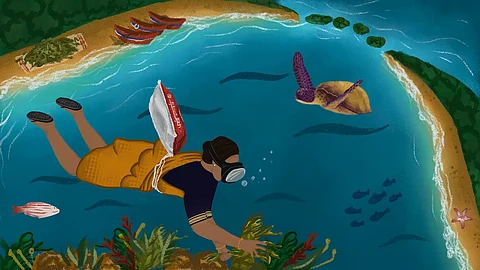
- Topics
- Feature
- Opportunities & Events
- About
- Hindi Portal
- Data
- Topics
- Feature
- Opportunities & Events
- About
- Hindi Portal
- Data

By the time dawn breaks over the Gulf of Mannar, the women of Ramananthapuram district in Tamil Nadu would have already finished their household chores. They hop on boats and set off to the islands with their packed lunch boxes and some bare essential gear. With their goggles in place and plastic bags tied securely around their waists, they dive into the blue waters of the sea. For the next 3–4 hours, they skillfully gather seaweed from the rocky underwater terrain, filling their bags with this precious resource. Meanwhile, the accompanying men tend to the retrieval of the nets laid out the previous night, gathering the day’s fresh seafood catch. By afternoon, they return to the shoreline, spread out the seaweed to dry, bundle it up, and sell it to local industries in and around Ramanathapuram.
This is what a typical workday looks like for several women from Ramanathapuram and the neighbouring coastal districts in southern India. Ramanathapuram’s coastline stretches along the eastern side of the Gulf of Mannar, providing access to various islands and coral reefs. Seaweed harvesting is a traditional occupation in this area, passed on from mother to daughter through the generations. Many of them now cultivate seaweed in the shallow waters of the ocean.
The uniquely biodiverse Gulf of Mannar
The Gulf of Mannar is a large shallow bay in the Indian Ocean along the southeastern coast of India. It is dotted with a chain of 21 small islands, and also the famous Rama Setu, a series of limestone shoals that almost connect India to Sri Lanka. This UNESCO global biodiversity heritage, renowned for its rich marine biodiversity, came under the forest department's jurisdiction in 1986, forming a national park spanning 10,500 square kilometers. It is also the first Marine Biosphere Reserve in South and South-East Asia. It provides a habitat for rare species like sea cows, dolphins, and corals.
The Gulf also hosts mangroves, seagrass beds, and vibrant coral reefs, and carries a rich history of trade and connectivity between the two countries. The Tamil Nadu Forest Department has been gradually discouraging and penalizing the practice of diving to collect natural seaweed from the islands within the area. The traditional profession of harvesting is now teetering on the edge of a precipice.
A growing shift towards cultivation
Seaweed, known as kelp, are marine algae having diverse uses as food, chemicals, fertilizer, and also in pharmaceutical industries. Although seaweed cultivation has a long history in East Asian countries like Japan, Korea, and the Philippines, it gained popularity an India since the 1980s. The central government institutes introduced cultivation and harvesting techniques for economically important seaweed species like Kappaphycus as a livelihood option for the coastal communities to reduce pressure on overexploited fish and other marine resources, especially in threatened marine ecosystems or protected areas. In the 2000s, Pepsico began commercial cultivation of Kappaphycus alvarezii in parts of Tamil Nadu, offering jobs and income to local residents.
India contributes approximately 0.2% to global seaweed production, ranking 13th worldwide according to FAO estimates. However, with recent growth reaching over 72,000 tonnes in 2023 and government-backed plans to scale production to 1.12 million tonnes by 2025, India is positioning itself as an emerging player in the global seaweed economy. In the buffer zone regions of Ramanathapuram, Tuticorin, Tirunelveli, and Nagercoil districts in Tamil Nadu, villages have embraced seaweed cultivation. More than a thousand families across 126 villages in Rameshwaram alone cultivate Kappaphycus seaweed in shallow waters. More than 17 different products are supposedly made with the seaweed harvested off the coast of southern Tamil Nadu in the Gulf of Mannar. The cultivation process involves tying small seaweed clumps, also known as “pasi” in Tamil, to bamboo rafts and nurturing them in shallow waters for around forty days before harvest. Once collected, the seaweed is dried, bundled, and sold to local marine industries.
Seaweed cultivation is recognised for its role in carbon sequestration, reducing nutrient pollution, and providing livelihoods to coastal communities. It is also valued as a nutrient-rich “superfood” and can potentially enhance food and nutritional security. The commercial value of seaweed is highly regarded, providing relatively good incomes for everyone involved.
However, there are concerns about the growth of the non-native seaweed species, Kappaphycus, and its potential harm to the coral reefs in the Gulf of Mannar region. Some of the local people believe that Kappaphycus alvarezii has halted the growth of the other seaweed.
Although some experts refute claims of its invasive potential, arguing a lack of concrete evidence to prove its ecological harm, the issue remains a topic of discussion.
Navigating Through Rough Waters
The fishing villages in this area are surrounded by diverse marine habitats. These habitats are home to a wide range of marine species, including critically endangered mammals like the dugong, Indo-Pacific bottlenose dolphin, various whale species, and endangered turtles. Fishing communities often encounter these remarkable creatures during their fishing trips. However, the women who rely on diving and collecting natural seaweed face daunting challenges to their livelihoods from the Forest Department as no extractive activity is allowed in this area.
While industrial pollution, overfishing, and exotic seaweed cultivation continue unabated, enforcement efforts have disproportionately targeted the small-scale activities of local communities. This emphasizes the urgent need to support and actively involve coastal communities in conservation efforts, especially as the valuable climate and nutritional benefits of seaweed gain recognition.
Citations:
Story by Vikram Aditya | Edited by Aditi Sajwan | Art by Muskan Gupta
The article belongs to a three-part series on Biodiversity and Sustainable Agriculture in India, an initiative by the Biodiversity and Agriculture team of Biodiversity Collaborative. The series is supported by the Rohini Nilekani Philanthropies.